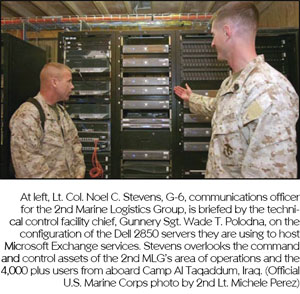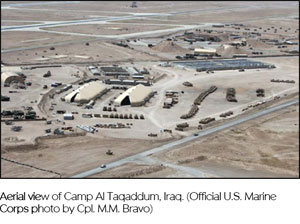|
June 2009 | Volume 12 / Number 6
Cover Story
IP Joins the Marines in IraqBy: Richard “Zippy” Grigonis
My late father was Marine back in the early 1920s, stationed in Quantico, Virigina. He marched in Warren Harding’s funeral procession. A physical fitness buff, he later defeated the amateur wrestling champion of Germany in a match staged by the Marines and the German Amateur Athletic Association. He had occasion to meet General Biddle and General Butler. (After Pearl Harbor, at the age of 40, he enlisted in the U.S. Army. Even at that age, he managed to regularly come in 2nd place on the obstacle course, but that’s another story.) Yours Truly was thinking of him the other day when an offer came in to interview Lt. Col. Noel C. Stevens of the Marine Logisitics Group, which is currently forward-deployed to Camp Al Taqaddum, Iraq. Lt. Col. Stevens is the unit’s communication’s officer, which overlooks the command and control assets for a large area of operations and for more than 4,000 service members. Naturally, I jumped at the chance to find out what kind of communications technology is in use over there. RG: Lt. Col. Stevens, I must admit I’m unfamiliar with what kind of communications infrastructure is available to the U.S. military in Iraq these days. First, can you give me a general description of what duties you perform at Camp Al Taqaddum? Lt. Col. Stevens: I’m a Lieutenant Colonel in the Marine Corps with over 21 years of service. I am the Assistant Chief of Staff, G-6, responsible for providing all the data, voice and video services to the Commanding General and his staff. The communications services I oversee enable information exchange throughout the Command. I think my civilian equivalent role would be that of Chief Technology Officer. Our network provides Unsecure Internet access, Secure network capabilities, voice (both POTS and VoIP) and video-teleconferencing services to about 5000 military and civilian users. It is a very mature network that has been maintained and operated in Iraq, and throughout the Al Anbar province, over the last five years. RG: When members of the telecom-savvy public hear about a place such as Camp Al Taqaddum — the Army’s former “Forward Operating Base” (FOB) Ridgeway — what generally comes to find is a tactical operations center running a large, complex, tactical combat communications system utilizing satellites and exotic wireless technologies, all employed to communicate with and coordinate the activities of observation posts, directing the movements of platoons, etc. using heavy encryption techniques and technologies. In the civilian world we now have Voice-over-IP (VoIP) and other forms of packetized communications, mobile unified communications, fixed-mobile convergence (handsets that can maintain communications despite passing from one type of network to another — e.g., cellular to WiFi (News - Alert)), multimedia call/contact centers, and the automatic intelligent routing of phone calls and other types of media depending upon the identity of the caller and who he/she is calling. Is there much “overlap” between what the USMC does in terms of communications and what happens in the civilian world? For example, I’ve heard that your infrastructure uses both IP and other packet-based communications. Lt. Col. Stevens: There is a tremendous amount of overlap with technologies in use in the civilian sector and with the military network that is currently deployed in Iraq. As communications professionals, the Marines here are constantly reading journal publications, taking advanced technology courses and observing what types of technology are being used and how those technologies are being used in the civilian sector, with an eye towards solving a problem we may be facing locally. Our network recently underwent a commercialization initiative, wherein we replaced a large portion of our tactical military systems with commercial, off-the-shelf equipment. In addition to the commercialization effort which primarily targeted our transmission layer and back office equipment suites, we also use a number of commercial collaboration tools. The MLG (Fwd) staff relies upon real-time services to quickly and efficiently exchange information across the operational area. Throughout the Command we observe daily use of VoIP technology across both our secure and unclassified networks, collaboration tools such as Adobe Connect, desk-top VTC capabilities as well as studio-based VTC suites and IRC Chat applications. Of course, for any of these tools to work effectively, the network has to be stable and capable of providing the bandwidth required- our goal is bandwidth sufficiency and the commercialization of the infrastructure has helped us achieve that to a large degree. As far as specific commercial technologies; to support our VoIP services we are currently using the Cisco (News - Alert) call manager 4.2(3)sr1 in conjunction with our Cisco backbone at layers 2 and 3, and we attempt to make things run more efficiently by using Quality of Service (QoS) statements for all of our real-time services. We also use a Vocality (News - Alert) multiplexor which allows us to extend POTS services across our IP network. This lets us push voice capabilities out to some of our more remote areas, using a Very Small Aperture Satellite Terminal (VSAT), again a commercial transmission system. Finally, we multi-cast live video feeds from the U.S. (FOX News and CNN for example), as well as from unmanned aerial surveillance platforms, such as Shadow or Predator, over our IP network. This is very similar to IPTV (News - Alert) technology.
Lt. Col. Stevens: It’s really a combination of both, there is a mechanism in place that allows the services to identify an emerging requirement and push it through the military procurement process a little faster. The “universal needs statement” is a requirements identification tool that the armed services can use to identify a shortfall with regard to a specific capability — whether that is a warfighting capability or a telecommunications capability. The process was used much more extensively during the early years of Operations Iraqi Freedom and Enduring Freedom (OIF (News - Alert)/OEF) in order to procure state-of-the-art equipment that was used to build the network that we have in place now. This process took advantage of Commercial, off-the-shelf solutions, purchased them and then delivered those solutions very quickly to the deployed forces. Of course the Marine Corps also has a systems command that is constantly looking into the future to anticipate needs and works closely with civilian industry leaders to develop technology in support of those anticipated requirements. That said, we try not to chase technology for technologies sake. We simply don’t have the time or money to throw at the latest gadgets. We have to ensure that the technology we employ is going to satisfy a validated requirement, identified by the warfighter. But I think that the greatest source of ‘R&D’ is resident in the inherent creativity and ingenuity of the individual Marine. I am constantly amazed at what solutions the Marines can come with up in spite of the constraints that they face. They often do not have access to all the resources that they would like, but when given the opportunity and latitude to solve a problem, they will. Not a week goes by that I do not witness what I like to call a “comm miracle”- an event where a Marine has performed some magic to make something work- on time- when there was not a reasonable expectation that it would. RG: What kind of non-C3 (News - Alert) communications infrastructure exists? Are there ways for service members to communicate with their loved ones back home? Lt. Col. Stevens: There are a number of ways that Marines can communicate with their loved ones back home. I am amazed at the amount of communications that are available in Iraq in 2009 as compared to what was available to Marines during the gulf war. I remember during the gulf war, there was an AT&T phone center a few miles away from where I was working and to make a phone call, Marines would walk to the phone center, and wait in a very long line in order to make a 15-minute phone call. Of course, the phone center was not there initially; my initial contact back home was via the Military Affiliated Radio System (MARS). MARS was a network of volunteer, amateur HF radio operators that would pass short messages, I think they were called Marsgrams, on behalf of the deployed service-members. It was almost like sending a telegraph; I think my first message home was something like ‘have arrived safely’. Things have certainly changed now. Marines at TQ have access to phone centers and Internet cafes and they even have the option of purchasing commercial Internet services for their living quarters. The speeds are not quite as fast as what they would get back at Camp Lejeune, North Carolina, but all things considered the ability to have Internet connectivity, in their rooms, while deployed is a significant achievement and goes a very long way in building and maintaining moral within the unit. Marines take advantage of the Internet access to chat, send email, surf the web, make Internet phone calls and video chat sessions using services like Skype (News - Alert). Without question, this is the most ‘connected’” deployment I’ve ever been on. RG: Thank you for a great interview, Lt. Col. Stevens. Hope to see you guys back in America as soon as possible. IT Richard Grigonis is Executive Editor of TMC (News - Alert)’s IP Communications Group. Today @ TMC
Headlines
Upcoming Events
MSPWorld
The World's Premier Managed Services and Cloud Computing Event Click for Dates and Locations Corporate News
|
|





 RG: Given the U.S. Military’s increasing reliance on Commercial, off-the-shelf (COTS) hardware and software, selling advanced communications technology to the military no doubt must be subject to a lengthy approval process. And yet your infrastructure appears to be state-of-the-art. Is there some “fast track” adoption process for telecommunications equipment, or does the USMC engage in some R&D of its own, designating particular companies to manufacture telecom network elements to its specifications?
RG: Given the U.S. Military’s increasing reliance on Commercial, off-the-shelf (COTS) hardware and software, selling advanced communications technology to the military no doubt must be subject to a lengthy approval process. And yet your infrastructure appears to be state-of-the-art. Is there some “fast track” adoption process for telecommunications equipment, or does the USMC engage in some R&D of its own, designating particular companies to manufacture telecom network elements to its specifications?
